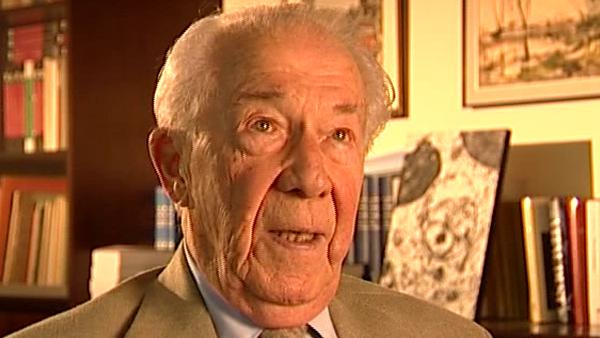NEXT STORY

Learning I'd won the Nobel Prize
RELATED STORIES

NEXT STORY

Learning I'd won the Nobel Prize
RELATED STORIES


|
Views | Duration | |
|---|---|---|---|
| 51. The first lysosomal storage disease | 126 | 04:29 | |
| 52. Dame Honor B Fell and vitamin A | 79 | 03:49 | |
| 53. 'Pericanalicular dense bodies' | 99 | 02:55 | |
| 54. Alex Novikoff | 196 | 05:25 | |
| 55. Uricase: Not a typical enzyme | 109 | 02:31 | |
| 56. Peroxisomes | 1 | 162 | 05:20 |
| 57. Becoming weary of teaching and administrative duties | 131 | 03:59 | |
| 58. Joining the Rockefeller Institute | 100 | 02:59 | |
| 59. A dual life between New York and Louvain | 121 | 04:01 | |
| 60. Jacques Berthet and Miklós Müller | 169 | 05:16 |


Berthet was a unique man. He is still doing extraordinary things today: he's just written a dictionary of biology – a complete modern dictionary of biology. Anyway, he was an extremely bright man and he would be a sort of a... invaluable co-worker and colleague whenever I would... I would imagine some... some theory or formulate some theory or even some equation, I would always submit it to Berthet, and if there was a flaw in it, he would have found it. And so we really worked a lot together. Beaufay was also very good in theory but in addition, although trained as an MD, turned out to be an extraordinary self-taught engineer, and so he actually built a centrifuge rotor for density gradient centrifugation that was entirely automatic, that would fill and unload automatically while running... while running. I won't go into the details but this was a real feat of engineering; this rotor would run at 50,000 revolutions per minute, without exploding which was not... anyway, that rotor was in fact constructed partly in Belgium and partly in New York because the Rockefeller University was famous for its instrument shop which was run by a Swedish engineer, who was quite remarkable. And so these new machines were made partly in Belgium and partly in New York. So all that was... turned out to be extremely useful. I had some very nice co-workers in New York; also my graduate students were... Bill Bowers who did a lot of work on lysosomes in lymphoid tissues. I had another man called Brian Poole, who also was one of these extremely bright... I've been fortunate enough to have working with me two or three men – it happened to be men – who were superbly intelligent, much more intelligent that I can claim to be, and who really helped me tremendously in some of the more difficult formulations... theoretical formulations. Brian Poole was one of those... died stupidly of a diabetic coma in a Norwegian hotel, very young. So there was Paul Lazarow who did enormous work on the biosynthesis of peroxisomes. So, you see, both in New York and in Belgium we worked on all kinds of different aspects. There was another man in New York called Miklós Müller – he was a Hungarian morphologist who Novikoff had invited to attend the Ciba Foundation conference in 1963, a conference on lysosomes, and who had done some cytochemical work with this primitive techniques that he had in Budapest, and he eventually joined my lab and moved from Hungary... immigrated from Hungary to the United States; there's a period... a small period of thaw so that he could bring his wife over from Hungary. And he was a micro... a protozoologist and so he did a lot of work on lysosomes and peroxisomes in protozoa and ended up making a major discovery in some protozoa called trichomonas vaginalis, which is a parasite of the female digestive tract; he discovered new particles which actually make hydrogen, and he called them hydrogenosomes and... which quite recently, in the last few years, have been found to be relative of mitochondria, and this has become one of the major mysteries, this whole field or subjects of speculation and research: the relationship between mitochondria and hydrogenosomes which have very different enzyme equipments but seem to be genetically related – the evidence is... is very strong. So all those people... and many others that I haven't mentioned because I can't go on, but really helped very much in developing this whole field and I feel very much indebted to their help and their collaboration. And so, thanks to those two groups, I think we were able to make quite a lot of progress.
Belgian biochemist Christian de Duve (1917-2013) was best known for his work on understanding and categorising subcellular organelles. He won the Nobel Prize in Physiology or Medicine in 1974 for his joint discovery of lysosomes, the subcellular organelles that digest macromolecules and deal with ingested bacteria.
Title: Jacques Berthet and Miklós Müller
Listeners: Peter Newmark
Peter Newmark has recently retired as Editorial Director of BioMed Central Ltd, the Open Access journal publisher. He obtained a D. Phil. from Oxford University and was originally a research biochemist at St Bartholomew's Hospital Medical School in London, but left research to become Biology Editor and then Deputy Editor of the journal Nature. He then became Managing Director of Current Biology Ltd, where he started a series of Current Opinion journals, and was founding Editor of the journal Current Biology. Subsequently he was Editorial Director for Elsevier Science London, before joining BioMed Central Ltd.
Tags: Rockefeller University, Jacques Berthet, Miklós Müller, William Bowers, Brian Poole, Paul Lazarow, Alex Novikoff
Duration: 5 minutes, 16 seconds
Date story recorded: September 2005
Date story went live: 24 January 2008